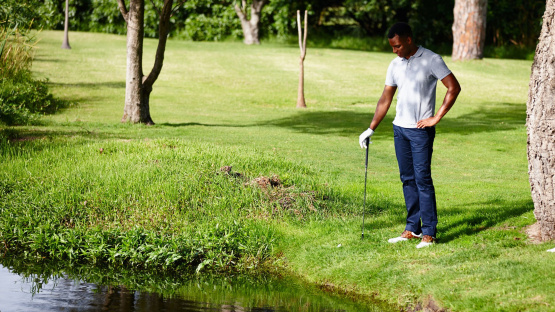What if I told you the game of golf and investing have a lot more in common than you think? Both require a keen understanding of strategy, patience, and an unwavering focus on the end goal. In both, success isn’t about quick wins or flashy moments of brilliance. It’s about the quiet, deliberate moves that build momentum, the disciplined choices that position you for success, and the ability to weather the inevitable ups and downs without losing sight of where you’re headed.
In the world of golf, this is called playing the long game. You step up to the tee box with a driver in hand, knowing that the next stroke will set the tone for the rest of the hole. You aim for distance, but also for placement—setting yourself up for a better approach shot, or at least avoiding the hazards. The long game is about looking ahead, thinking beyond the immediate stroke, and understanding that success on the course comes from stringing together smart, measured choices.
In investing, the philosophy is pretty much the same. Playing the long game in investing means you’re not chasing quick gains or trying to outguess the market. You’re not distracted by the daily swings of stock prices or the latest hot tips. Instead, you’re in it for the long haul, with your sights set on compounding growth over years, even decades. It’s about patience, discipline, and understanding that wealth is built slowly, over time, through calculated decisions and steady progress.
So, let’s explore how these two seemingly unrelated worlds intersect and what we can learn about playing the long game—whether on the fairway or in the financial markets.
The Tee Shot
In golf, it all starts with the Tee shot. You step up, take your stance, and aim down the fairway. Your primary objective is to cover as much distance as possible while avoiding trouble—bunkers, water hazards, or the dreaded trees that line the rough. You don’t need to sink the ball in the hole with this shot; you’re merely positioning yourself for what comes next. This is the essence of the long game in golf: setting yourself up for success in future strokes.
Now, think about your first major investment decision. You’re looking at a wide array of options—stocks, bonds, mutual funds, digital assets, or ETFs. Like that tee shot, your first choice won’t make or break your financial future, but it can set the tone. Are you investing in a safe investment product with competitive returns;, a solid, established company that will grow steadily over time? Or are you swinging for the fences with a hot, speculative stock that could either soar or crash?
Much like choosing the right club, which in this case is Wood for the Tee shot, long-term investors focus on fundamentals. They don’t get caught up in the hype or the daily noise of the market. Instead, they look for investments that have strong financials, a solid track record, and potential for sustainable growth. When you’re playing the long game, your first step is about positioning yourself for future success, not trying to score a hole-in-one on your first swing.

Traversing the Fairway
Once you’ve hit that initial shot and landed in the Fairway, you’re still far from the green—but now, you have a clearer path. The next few shots are about precision and consistency. You’re still aiming for distance, but you’re also thinking more tactically. You want to avoid the hazards, stay on course, and get closer to the hole. It’s not glamorous; these shots are often straightforward, focused on positioning rather than heroics.
In investing, this stage mirrors the middle years of a long-term investment strategy. You’ve made your initial choices, and now, it’s about maintaining a steady course. You’re contributing regularly, perhaps through auto-investing, where you invest a fixed amount at consistent intervals, regardless of market conditions. This approach helps you avoid the temptation to time the market—a dangerous game that often leads to disappointment.
Like a golfer on the fairway, a long-term investor understands that the journey to the “green” (in this case, financial independence) requires patience. There will be times when the market takes unexpected turns, just as there are windy days on the golf course. But if you stay the course, keep a steady hand, and don’t make rash decisions based on short-term fluctuations, you’ll make progress.
Hazards of Volatility


Of course, no round of golf—or investment strategy—is without its challenges. You may hit a perfect drive, only to have your ball land in a Bunker. Or perhaps you misjudge a shot, and now you’re deep in the rough. Hazards are part of the game, and how you handle them often determines the outcome of your round.
In investing, these hazards come in the form of market volatility. It’s inevitable: stock prices will rise and fall, sometimes sharply. Economic downturns, geopolitical tensions, or company-specific issues can send markets into a tailspin. But just as a seasoned golfer knows that panicking in the bunker only leads to more strokes, a long-term investor understands that reacting emotionally to market drops can sabotage a carefully crafted plan.
When you’re playing the long game, you don’t let a single bad day in the market throw you off course. You trust in your preparation, your research, and your long-term strategy.
Approaching Retirement and the Green
As you get closer to the green in golf, your strategy shifts. Now, it’s less about distance and more about precision. You switch to a wedge or a putter, focusing on fine-tuning your approach. One miscalculated chip could send your ball careening off the green, but a well-placed shot will leave you with a manageable putt. The short game requires finesse and patience—the same skills that will serve you well as you approach retirement in your investment journey.
For investors, the years leading up to retirement are the financial equivalent of the short game. You’ve spent decades building your portfolio, and now it’s time to adjust your strategy. You may shift to more conservative investments, reducing your exposure to riskier assets like stocks and increasing your allocation to bonds or other stable investments. Just as a golfer doesn’t use a driver on the green, a near-retiree isn’t looking for massive growth but rather stability and income.
At this stage, preserving capital becomes just as important as growing it. You’re nearing the final strokes of your financial journey, and the goal is to ensure a smooth transition into retirement, without jeopardizing everything you’ve worked for.
The 18th Hole


After a long round of golf, you finally reach the 18th hole. You’ve navigated the fairways, avoided the hazards, and now it’s time to sink that final putt. Whether you’re ahead of par or just happy to have finished strong, there’s a sense of accomplishment in knowing that your diligent, disciplined play has brought you to this point.
In investing, financial independence is the 18th hole. You’ve spent years, maybe decades, investing wisely, contributing consistently, and weathering the market’s storms. Now, as you step into retirement, you can enjoy the fruits of your labor—whether that means traveling the world, spending time with family, or simply living comfortably without financial worry.
Conclusion
And that’s how you play the long game in both worlds. Whether you’re teeing off on the first hole or making your first investment, the principles remain the same. Think ahead, stay disciplined, and trust the process.
In golf, it’s about getting closer to the green with every stroke. In investing, it’s about getting closer to your financial goals with every wise decision. And in both, it’s about savoring the journey, knowing that the long game—though slow and sometimes challenging—is the surest path to success.
Bravewood provides Nigerian professionals with low-risk, high-return investment products, licensed by the Central Bank of Nigeria.



